OIF Launches Flexe 2.1 Project and Elects new Board Positions and Working Group Representatives
This work continues OIF’s lead in FlexE aggregation architectures by keeping current with industry PHY rates
Fremont, Calif.—December 4, 2018 – OIF, the global industry forum accelerating market adoption of advanced interoperable optical networking solutions, today announced the launch of the FlexE 2.1 project and newly elected board members and working group chairs. The new project initiation and elections took place at the Q418 Technical and MA&E Committee meetings held October 29-November 2, 2018 in Sydney, Australia.
The new FlexE 2.1 project is for FlexE over 50Gbe PHY applications and an extension to the recently released FlexE 2.0 Interoperability Agreement (IA). FlexE 2.1 will specify a 50G FlexE frame and multiplexing format and will address Flex Ethernet (FlexE) applications with lower bandwidth needs and provide an implementation foundation for applications including the access layer of the future 5G mobile network. This new 50GbE support will extend the existing support for 100, 200 and 400GE in the just published FlexE 2.0 IA.
With market demand and possible large volume applications for channelization (5Gb/s granularity for minimum 10G clients) and bonding of 50GE PHYs in the future access layer/metro edge (based on IPRAN/PTN) of the 5G mobile backhaul network, FlexE implementation logic will be critical.
“There is continued demand by data center and network operators for a solution for flexible deployment and provisioning of Ethernet bandwidth,” said Dave Ofelt, Juniper Networks and OIF Physical and Link Layer (PLL) Working Group – Protocol Vice Chair. “Building on OIF’s great work for FlexE and FlexE 2.0, this new FlexE 2.1 project will ultimately result in a single IA that adds n×50Gb/s support to FlexE 2.0, along with other possible feature enhancements.”
Election Results
- Board of Directors:
- Nathan Tracy, TE Connectivity, was re-elected to the Board and appointed as President
- Tad Hofmeister, Google, was appointed as Vice President
- Martin Bouda, Fujitsu, was re-elected to the Board and appointed as Secretary/Treasurer
- Mike Li, Intel, was newly elected to the Board
- Cathy Liu, Broadcom Inc., was re-elected to the Board
- Gary Nicholl, Cisco, was newly elected to the Board
- Ian Betty, Ciena, continues to serve on the Board
- Officers:
- Klaus-Holger Otto, Nokia, was re-elected as Technical Committee Chair
- Ed Frlan, Semtech, was re-elected as Technical Committee Vice Chair
- Tom Issenhuth, Huawei Technologies, was newly elected Market Awareness & Education Committee Co-Chair, Physical and Link Layer (PLL)
- Lyndon Ong, Ciena, was re-elected as Market Awareness & Education Committee Co-Chair, Networking
- Dave Brown, Nokia, was appointed as Communications Director, having termed out as a Board member and Board President
- Technical Committee – Working Groups:
- Jia He, Huawei Technologies, was newly elected as Network & Operations Working Group Chair
- Jeff Maki, Juniper Networks, was re-elected as Physical Layer User Group Working Group Chair
“I am thrilled and honored to serve as president of the OIF for the coming year,” said Nathan Tracy, TE Connectivity and new OIF president. “This is an exciting time in the industry and OIF has an important role to play with the interoperability solutions that are both in-process and yet to come. I congratulate all the other members who are newly elected to the board of directors and other leadership positions.”
About OIF
OIF is where the optical networking industry’s interoperability work gets done. Celebrating 20 years of effecting progressive change in the industry, OIF represents the dynamic ecosystem of 100+ industry leading network operators, system vendors, component vendors and test equipment vendors, all collaborating to develop interoperable electrical, optical and control solutions that directly impact the industry’s ecosystem and facilitate global connectivity in the open network world. Connect with OIF at @OIForum, on LinkedIn and at http://www.oiforum.com.
PR Contact:
Leah Wilkinson
Wilkinson + Associates for OIF
Email: leah@wilkinson.associates
Office: 703-907-0010

